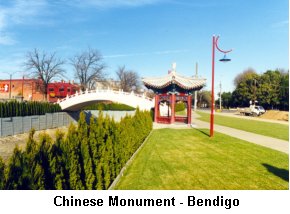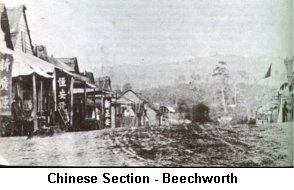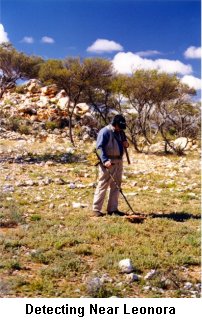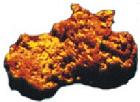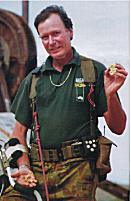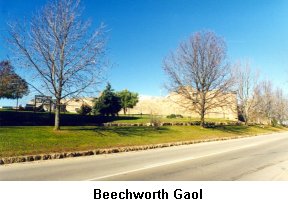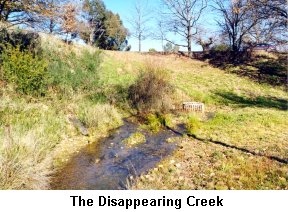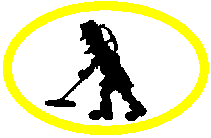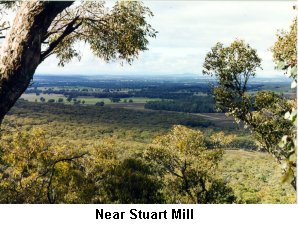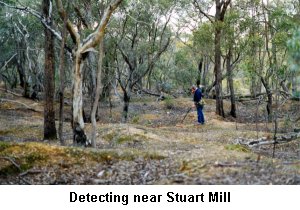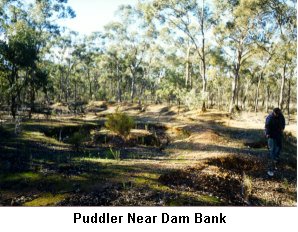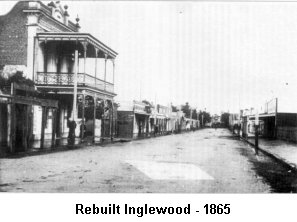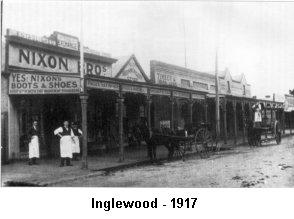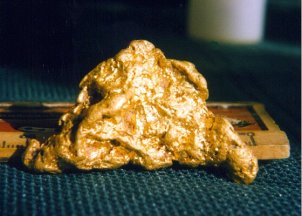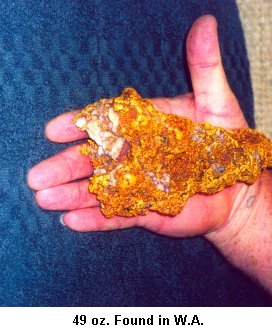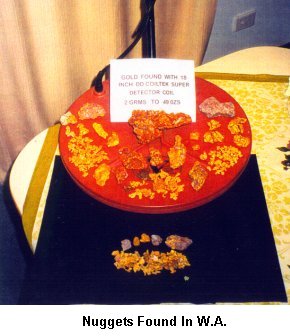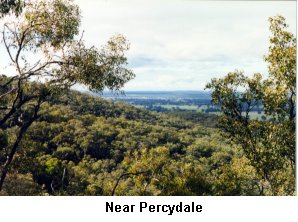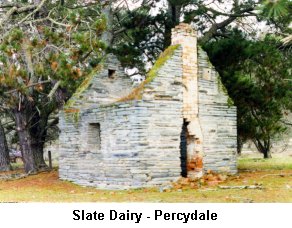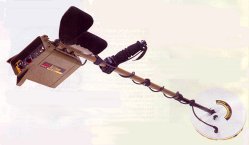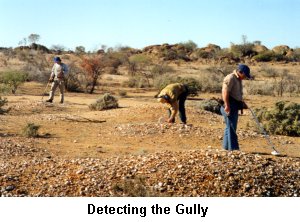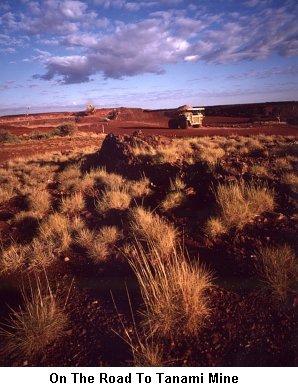
| August 1999 | |||||||||||||||||||||||||||||||||||||||||||||
|
|||||||||||||||||||||||||||||||||||||||||||||
Contents
|
|||||||||||||||||||||||||||||||||||||||||||||
| 1. EDITORIAL At the same time I was writing the editorial for last month's magazine the United Kingdom Government was selling off a good portion of the countries gold reserves. What prompts governments to sell off gold reserves knowing that such sales will have a detrimental effect on world gold prices defies logic. It is an unfortunate policy of the World Bank that supports such action. Fortunately, the Australian Government, through the federal treasurer, has openly stated that it will not be selling off gold reserves. Here at Gold Net we applaud this action, and strongly support policies that protect and support the gold industry.
With more nations likely to sell off reserves, the future of the gold industry in Australia remains tenuous. Many major companies involved in the industry are presently re-assessing the viability of their operations and we can predict that some companies are likely to wind down and close some unprofitable mining operations particularly those that are reliant on gold alone. Editor Email: [email protected] All material in this magazine is copyright and may not be reproduced in any part or form whatsoever without written permission from the publisher.
|
|||||||||||||||||||||||||||||||||||||||||||||
|
2. THEY CAME FROM CHINA by Craig Wilson The history of gold from the 1850's onwards in Australia would be incomplete without the inclusion of the enormous contribution made by the Chinese who visited this land to find their fortunes. Just where did these Chinese come from? Why did they come here and where did they go? The Chinese had been lured to the goldfields of California in the late 1840's and early 1850's. These Chinese were primarily from Canton Province and had travelled to the California via Hong Kong. Consequently there was knowledge of gold fields within China when the discovery of gold was publicized worldwide. The Chinese were well travelled and experienced traders in their local region and had been trading with other nations from as early as the 12th century. From that time on China had a history of not just trading with other nations but encouraged its people to visit and work in other lands. Consequently there was a history of the Chinese in Australia before gold was found. Most of them were undertaking manual labouring jobs, working tending stock, cooking and undertaking laundry duties and other similar activities.
As travel costs were high to reach Australia, Chinese moneylenders would loan funds to the emigrants to reach their destination. All loans were undertaken by verbal agreement and honoured. The arrangements were that the Chinese would travel by barge to Hong Kong and from there, board ships bound for Melbourne, Victoria. These sailing ships were under a variety of flags. British and American predominated but there were other ships that plied the trade in human cargo. The fare to reach Australia was ten pounds. This was an enormous sum for the emigrants and it was well understood that this had to be repaid with interest. Most of the men who travelled to Australia were from rural villages and were hard workers. They were hard men. Leaving their families behind so their wives and children could carry on with the work of tending their garden plots and looking after their extended families was a practical necessity. Consequently the Chinese visitors to Australia were almost all male and there were only one or two women who actually travelled to Australia to the goldfields. The European shipping owners treated the Chinese as "cargo" rather than as fare paying passengers. Many of the ship's manifests would describe their cargo as "Chinese". The journey could take as little as 6 weeks or as long as 4-6 months depending on the trade winds. The depredations suffered by the Chinese were horrendous. They were kept below decks for almost the entire journey and ablutions were addressed by hauling human waste onto the decks in buckets. Several Chinese died while in transit.
When they eventually reached Port Phillip the Chinese cargo was disgorged onto the docks where they were gathered together and moved to a staging camp run by Chinese agents. Collecting provisions and being briefed by local Chinese the human cargo was soon on its way on foot to the goldfields. There was a Chinese Society established in Melbourne that essentially looked after Chinese interests in Australia. It was clan like and required each Chinese who landed at Port Phillip to register and pay a small sum that would ensure the interests of the member would be looked after. The organizations aim was to promote their well being, provide small loans, and educate the members in the local laws of the land. The Society was quite democratic and did in fact fulfil its role quite effectively. There is little doubt that the arrival of the Chinese was at first tolerated by the Europeans, but with ever increasing numbers some dissension was soon evident. The overwhelming numbers of Chinese arriving in Australia was soon brought to the attention of the authorities and in time a levee of ten pounds was required to be paid for every Chinese landing in Victoria.
Once on the gold fields the Chinese remained within their own society. Most were unable to communicate in English and their mannerisms, religion and general living methodology were entirely foreign and not understood by the Europeans. It should be understood that for centuries the Chinese were led to believe that theirs was the most advanced civilization on earth and that all other living humans were inferior, and were in fact "barbarians".
The misunderstandings and prejudices were magnified on both sides with the customs and ways of each society not being understood by the other.
To their credit the authorities recognized the difficulties and appointed Chinese protectors to provide protection against unscrupulous and misunderstood individuals and groups. The police and gold Commissioners were instructed to be tolerant and there are many recorded instances of both the police and gold Commissioners providing protection to the Chinese. The Chinese unfortunately suffered greatly. Their culture was vastly different from that of Europeans cultures. Among other things their waste of water was a constant source of dissention with the diggers who knew and understood the value of this precious commodity in this barren and dry land. Additionally as they had no woman with them it was widely thought that homosexuality was widely practiced. The Chinese never intended to settle in this country and their demeanour and behaviour reflected this. Rarely did they erect permanent structures and almost always lived in tents. There were some notable exceptions to this rule, as at Beechworth. In some instances they did discover new gold fields as at Ararat, but they were more likely to re-work old diggings and made enough to pay their way in this manner. They were not Christian and were considered Pagan by the European diggers who held them up to ridicule. The first recorded dissention against the Chinese in an organized manner erupted in mid 1854 at Bendigo. This powder keg was diffused by the District Commissioner, Panton and the Police Magistrate McLachlan. Later that year another powder keg at Ballarat exploded at the Eureka Stockade, and the subsequent Royal Commission heard evidence about the miner's grievances with the Chinese, as a side issue. This resulted in the iniquitous tax of ten pound for each Chinese landing in Victoria, previously mentioned being imposed. Guichen Bay at Port Robe in South Australia became a major disembarking point for the Chinese and some 16,000 landed here and walked overland to the Victorian goldfields. As time progressed and the numbers of Chinese steadily increased several affrays were reported, from various gold fields. Usually the Chinese were on the receiving end and deaths and injuries were reported. The first major uprising against the Chinese occurred on the Buckland River diggings in the north east, in July 1855. This affray was a disgraceful exhibition of racial prejudice and remains today a blot on the history of this country.
|
|||||||||||||||||||||||||||||||||||||||||||||
by Jim Foster Our new camp is on a slight rise. This rise is a gold bearing reef that appears briefly before sliding back into the earth. Only five hundred yards long and about a 150 wide the reef didn't produce much gold, but it did provide a nice dry campsite. Firewood was in abundance as dead mulga trees lay everywhere amongst the living. Mulga is a small tree of pleasing appearance despite it being gnarled and twisted by its hostile environment. Surprisingly, for a desert tree it is shallow rooted but can survive prolonged drought with impunity. When dead and dry the wood is very heavy and dense. When burnt it gives off prodigious amounts of heat. BACK ON THE GOLD I felt we had found most of the easy gold when we had been here before so I suggested we grid some of the ground already done using the chaining method. To chain is to tie a length of chain to your belt. The chain drags along behind the many links clearly marking the earth. The idea is to outline a spot with the chain then work back and forth across the outlined patch. Each pass is about one yard to one side of the previous, ensuring no ground is missed. Cheryl opted out of chaining, she dislikes working in the one spot for long so it was decided I would chain the patches that Cheryl, as roving scout, would find. CHAINING OUR FIRST PATCH Most of our gold had, up until we found this spot, been just scattered nuggets. On this slope we had found 11 gold nuggets ranging in size from less than a gram to about 9 grams. The area was less than two acres. A slope on the side of a rich reef. The reef had been mined a hundred years ago but no one had found the nuggets until metal detectors were introduced in the late 1970's. When we'd found this slope it had already been searched every year for over twenty years. Old detector dig holes were everywhere, some of them very deep indicating large nuggets had been found. But we have an edge, we have the latest in nugget hunting technology, the Minelab made SD2200D. These machines detect gold up to four times deeper than conventional detectors. Coupling these detectors with the latest Double D wound search coils from Coiltek we felt we had an unbeatable combination.
THE ROVING SCOUT Cheryl had been busy scouting for another patch. Walking miles each day with her detector she had found several scattered nuggets and another area we thought may be worth chaining. This spot was a narrow strip of about three hundred and fifty yards by seventy. Eagerly I sized up the area and began work. Immediately I began to find gold. Old detector dig holes were everywhere but still I continued to find nuggets down deep on the cap-rock. Some I even found beneath old dig holes. Three days later I finished that spot and added another three ounces to our growing tally. As chaining is a job that ties you to one place and demands total concentration I felt I needed a break, we went looking for new ground. LONELY GOLD About five kilometres to the north we found a likely spot. The ground looked good but there were no old workings visible. Remembering the old saying, "if it looks good, detect it," we began. After about fifteen minutes I got a good signal and dug a nice little three gram nugget. We were delighted. We had proven the presence of gold where no one before us had found it. Enthusiastically we began to search for more nuggets. If we had found a patch of gold then it wouldn't be long and we'd find more. Two hours later we concluded that nugget was a loner, no more nuggets could be found, this wasn't a patch. Disappointed but not defeated we drove off in search of another likely spot. Following a very faint track we finally came to some good looking ground. Half an hour later I dug a good signal and found a seven and a half-gram nugget. Surely this was it! Two hours later we decided to give up. There was no more gold there that we could find. They were just very lonely nuggets. BOWER BIRD ROCKS Agreeing that two disappointments were enough for one day we decided to drive back along the breakaways. This is a low, broken escarpment where piles of granite boulders sat in lonely isolation in country that had a beautiful park-like appearance. Running roughly north south it is extremely pretty country but has no signs of mineralization, so no gold. Coming to a fork in the track about five kilometres south we were intrigued to see a track meander into the broken country to the east. Checking our maps, then our position with our GPS, (Global Positioning System) we found we were close to a spot with permanent natural water, a rare occurrence in this part of the country. Slipping the 4X4 into gear we turned to investigate. Emerging from between two immense boulders we found ourselves gazing in wonder at the scene before us. Flowering corkwood trees lined the track that wound across short, dry grass. Wildlife was everywhere. Wallabies peered from rocks as we passed while curious emus came to follow us along the track. A short distance later we came upon a washed out creek crossing. We could have crossed in four-wheel drive but Cheryl saw rushes lining the creek bed and guessed water was not far away.
At first I didn't see what she was pointing at, then I saw the most perfect bower-bird bower that could be imagined. Never having seen these rare birds in the wild before we were extremely excited when the male bird flew into the overhead tree scolding us in a loud, shrill voice. Crossing the pool we peered into his bower. Built under the shade of the tree but sited to catch the morning sun the bower had a water frontage. Pure white bones mixed with fragments of green and brown glass lay in an inviting carpet before the bower. Closer examination revealed such treasures as shiny brass cartridge shells, brightly coloured seeds and tufts of emu feathers. In the bower itself lay the crown jewels, large green seeds that gleamed like polished emeralds. Surely this must be the richest of bowerbirds. Cheryl added to his outdoor collection a bright blue drinking straw and a gleaming silver bullet shell. "That should please his lady friends," she said with a grin. A bower bird bower is built by the male bird to attract the female. He gathers any bright object he can find to decorate his boudoir. If impressed enough the female will consent to mate with the male, hence the immense effort the male will make to construct the most alluring bower. Leaving the bower we climbed the granite dome and found more water holes in the creek above. The view from the low crown of the dome was breathtaking. In the golden light of a lowering sun we gazed across the park-like countryside. Groups of kangaroos and wallabies grazed peacefully alongside haughty emus. Evening birdsong came clear on the still, warm air. Nugget hunting has rewards that are more beautiful and enduring then gold. This was a day we would long remember. All too soon it was almost time to leave our campsite on the reef. On our last day Cheryl was detecting on a likely looking flat when she found three lovely nuggets close together. We were very happy when we found these three beautiful nuggets brought our total weight in gold to over the ten-ounce mark. Our next move was to be to country new to us. It was to be another exploration into the unknown.
by Christine Whittington The history of gold at Beechworth is a long and torrid tale. Gold here in the late 1850's was plentiful and the history of the area indicates that Beechworth was more that just another gold producing area. It was in fact a major Government centre where a great deal of infrastructure was built and today a considerable proportion of those buildings remains intact and some are still in use. Beechworth is indeed an outstanding example of posterity preserved. It is rare today to find anywhere in Australia a town with a history so well preserved or with such historical significance relevant to the entire country. Beechworth is just over 200 miles north east of Melbourne and is tucked away in the low foothills at the base of the Great Dividing Range. With a population of about 4,000 the town is a magnet for tourists and is just off the main Sydney, Melbourne highway. On all weekends and holiday periods tourists inundate this area to enjoy the history, climate and general welcoming attitude that exists in this touch of paradise. The al fresco dining areas and welcoming eateries are a feature. The Beechworth Bakery has a reputation worldwide as a fine place to enjoy the outstanding products baked here. What draws tourists to Beechworth is clearly the golden history of its past. The old government buildings alone still in the town would take a day or two to visit and to enjoy the preserved heritage. Buildings, such as the present Post Office was completed in 1870 and replaced an older building that burnt down along with a good proportion of the town on the night of Saturday 23 March 1867. The fire, which began in the stables of the Empire Hotel in Camp Street raged out of control. The hydrant attached to the towns water tank failed frustrating the town's fire brigade and the fire quickly spread. The Town Hall and Shire offices, built in 1858, are beautifully preserved and are much the same as they were when built.
The Burke Museum houses a fine collection of memorabilia of both gold mining activities and relics relating to the Kelly Gang and aboriginal regalia. The Museum is named after Robert O'Hara Burke, an Irishman who served in the Hungarian Hussars and with the Royal Irish Constabulary before immigrating to Victoria and joining the police force. He served as the police Superintendent at Beechworth from 1854 to 1858, and distinguished himself for the manner in which he dealt with the riots against the Chinese in 1857 at The Buckland. His greatest claim to fame was his unsuccessful expedition to cross the continent from south to north, where he perished with his deputy Wills in the harsh outback on the return journey. In memory of this great explorer the town's people of Beechworth renamed the Public Library and Athenaeum, the Robert O'Hara Burke Memorial Museum.
The Beechworth Gaol was originally a wooden stockade, but was replaced by the present gaol, which was completed by 1864, after 5 years work. A section of this internment facility was utilized as a lunatic asylum and several Chinese interned remained there until their deaths. Historians suggest that many of these men were improperly interned.
The Chinese section of the cemetery in the town reflects the fact that a large number of Chinese lived and died here. Although these people were here in numbers they were scattered throughout the region and worked a number of mines and alluvial diggings. In 1857 European miners rioted against the Chinese and considerable displacement and mayhem occurred until order was restored by re-enforcement's of mounted police commanded by Superintendent Burke. A large section of the local cemetery contains a number of gravestones with Chinese inscriptions. The Chinese contribution to the history of this area is now well preserved and respected. Most of the gold in this area was recovered via sluicing operations. Water was plentiful here and a massive construction program to build water races was undertaken. Incredibly over 900 miles of races had been constructed in the Ovens gold fields in the vicinity of Beechworth. Over 14,000 sluices were operating in the Beechworth District alone, which gives rise to the massive gold recovery operations that existed here. One of the most fascinating features of the area is a creek not far from the post office, near the tennis courts that disappears down a man made hole. It is well known to locals but not so well known to tourists. In 1876 the Rocky Mountain Extended Company cut through almost solid granite under the town to provide water for sluicing operations and to allow the wash water to drain away successfully. The tunnel extends under the main town for 2600 feet and emerges in bushes near the Newtown Falls on Spring Creek. A remarkable engineering feat, that returned investors a yield of about 9,000 oz of gold.
|
|||||||||||||||||||||||||||||||||||||||||||||
|
|||||||||||||||||||||||||||||||||||||||||||||
|
|||||||||||||||||||||||||||||||||||||||||||||
|
|||||||||||||||||||||||||||||||||||||||||||||
|
5. THE LEGEND OF LASSETER - Part 6 Craig Wilson Lasseter's position was critical. Without water and with very little likelihood of being able to reach it without assistance, he turned his thoughts to the indigenous inhabitants. As he re-traced his steps he was suddenly confronted by a group of black figures. All men and with spears and nulla-nulla's. They approached cautiously and eventually Lasseter offered them food from what he had. Gambling on other members of the expedition finding him, he gave most of his food to the black men. Asking for water he was given that life sustaining fluid by the blacks. The rest of the group closed in around him. Lubras and piccaninnies, (small children) joined the group. They were intensely black, all totally naked and in their own way remarkably beautiful. From the beginning Lasseter knew he was not favoured by the chief, Watta Mitta Mitta. In fact from the snippets of language he had previously learnt from other blacks he was well aware that Watta Mitta Mitta was intent on killing him. Lasseter was obliged to remain with the blacks as precarious as his position was. He had no alternative. As the days passed an old gnarled black man from within the tribe befriended him, and they would spend considerable time together. Somewhat frail with age, he had a large wart on his back. Lasseter dubbed him "Old Warts". The old man protected and provided for him, as the days passed. Food was scarce, and the tribe went days without food, but always found water even if they had to travel up to 30 miles to the next watering point. As the days passed, Lasseter knew his strength was waning. Watta Mitta Mitta was still urging the tribesmen to kill him. Lasseter in turn had his friends from within the tribe. Old Warts was protecting and providing for him as best he could. Many of the older Lubra's became fond of Lasseter s he praised their children. He used every trick he could think of to survive. While Lasseter was enduring his predicament, other events were unfolding further east that were to move the focus from locating the adventurer. As the new plane headed west in search of Ilbilba it had become hopelessly lost, and eventually the two crewmen had landed safely when out of fuel. They endured great hardships, as they carried little food and water. For three weeks they stumbled about throughout the bush, eventually finding permanent water and remaining there. Considerable resources had been deployed when it was recognized that the two aviators had been lost. A squadron of RAAF planes had been sent from Melbourne, and ground parties had left from Alice Springs and Hermannsburg in search of them. Not knowing of Lasseters predicament and believing him to be safely somewhere in the desert west of Ayers Rock, the focus was clearly on finding Captain Pittendrigh and Hamre. With all their water now gone and with no food, the two men waited for their inevitable deaths. Then it was heard. In the distance first and then growing louder every moment. It was the sound of an aircraft. Both men jumped up and waved frantically as the plane roared over them, turning sharply with the pilot waving in recognition. Food and water fell from that small aircraft and the next morning they were located by a ground party and returned to Alice Springs. Lasseters predicament was worsening. Living as aboriginals did was foreign to him, and their nomadic way of life and food gathering were taking a terrible toll on his health. The diet was completely foreign to him. Goanna, lizards, yams, native fruits, roots and the occasionally wallaby were too much for him, and stomach upsets were common. The primitive living conditions of these nomads were too much and his health was failing. Taylor had been recalled from Ilbilba to assist in recovering the lost aircraft. After completing this task with his usual efficiency, he was instructed to set out with Johns in search of Lasseter. The focus on Lasseter was returning. When Taylor and Johns reached Ilbilba there was no sign or word of Lasseter. With black trackers they headed into the desert country to search for him. Unfortunately Taylor became very ill and was forced to return to Hermannsburg, where he asked Bob Buck of Tempe Downs Station to take up the search. Buck was an experienced bushman, and for the next eleven weeks searched for Lasseter. As his strength slipped away, Lasseter looked more and more to Old Warts and his Lubra, who looked after him when Old Warts was away on hunting trips. With failing eyesight and dysentery recurring at regular intervals he was now a pitiful sight. Watta Mitta Mitta was still urging his warriors to spear him, as he was a clear burden to their own survival. Old Warts would have nothing to do with it, and continued to protect his white friend. As the weeks slipped by with no sign of relief he so much expected and with failing health, Lasseter could go no further. He died a peaceful death with Old Warts nearby, looking over him as he always had, under a bright starlit sky in the crisp clean air of Central Australia, among his aboriginal friends and enemies.
Bob Buck continued his relentless search. From Ilbilba he followed the fading tracks using black trackers, until they vanished in Gibson's Desert.
Buck persisted and eventually came across a large tribe, who, on seeing him took off. He tracked them for over 30 miles. This was a large tribe. Over 200 that he had counted before giving up the count. When questioned they were decidedly silent on the question of the white man. This roused Bucks
suspicions and persistence resulted in a group of natives guiding him to a clump of dried bushes where he found Lasseter's body. Despite what Lasseter had written, the exact location of his El Dorado remains lost to this day. Many expeditions, some meticulously planned have failed to find the landmarks described in the general location. Old prospectors deny that there is any auriferous country in the general location, and most have dismissed the whole saga, as being purely speculation and probably misguided twaddle. Whatever the truth of the matter, the saga and location of Lasseter's reef has remained a mystery for 60 years. Snippets of information gathered from old records and from the family have provided researchers with a compelling but mysterious conundrum. Perhaps the true story will never be known.
The question remains - does this gold reef exist? I have always been an optimist, and tend to believe rather than disbelieve.
|
|||||||||||||||||||||||||||||||||||||||||||||
|
|||||||||||||||||||||||||||||||||||||||||||||
|
6. DETECTING STUART MILL John Forrester i have always considered carefully where I would detect and being a somewhat fastidious fellow, I undertook a lot of research before making a sojourn to the Stuart Mill area about 20 miles south of St. Arnaud. Now Stuart Mill is really just a dot on a map with an intersection and two or three houses. There was once a small store there but this no longer exists and although the community is small it is close knit and reflects the true heart of this country. I knew a couple of people there and although I had not visited for some years, made the obligatory phone call about a week before going there to renew acquaintances and arrange access onto some private ground that had produced gold before. On the due date the weather was appalling, and although I waited for the weather to clear, the rain just kept coming down. Well the best laid plans of mice and men do go astray, so I phoned and cancelled the day. About a month later the weather was perfect and so at the appointed time I arrived.
Now I knew that most of the gold from Stuart Mill had been at depth, but there were some areas that the gold broke through to the surface and good gold had been recovered there. Many of the creeks in the area, and there are plenty, contain gold. However it was not this gold that I sought - but gold from detecting near the surface. I decided to try the area behind the local reservoir. Incidentally this reservoir was build by the locals early this century to supply water to Stuart Mill and it has served the community well as a private source of water. Now the country behind this reservoir is indeed spectacular. It is a fabulous area for bush walking and the flora and fauna is both friendly and prolific. You could rightly describe this forest as God's own country. Not far into this forest along the main track in - is a small hut built by the locals, with bush toilets nearby. Now bush toilets perhaps need some description. These are constructed by digging a rather deep hole into the ground - perhaps some 10 feet deep and about 10 feet long. They are only about 2 feet wide and over the top of this hole a bench seat is constructed with a prominent orifice similar to that of a normal toilet is constructed.
Getting back to the task at hand I parked my vehicle, donned the detector gear and took off into the bush firstly on a reconnaissance and then to detect in earnest. I walked through this untouched bush for about an hour and although it was relatively steep eventually found some shallow diggings. They appeared to be untouched with no obvious detector holes evident. I was using a Minelab 2200D with a Coiltek 450mm coil, and expected to find good gold. I worked the area for about 2 hours and all I found was a few old rusty pieces of ferrous material. I began working the slopes away from the diggings and it was here that I was more successful. I found three or four small pieces of gold on one of the slopes intertwined with quartz. I had thought that here I might have found larger pieces but I was mistaken. After about 2 more house without success I decided to head back to my vehicle and make for some private diggings that I had previously arranged to access. Reaching this area I was joined by Bridget, Shirley's daughter. Now young Bridget was a scrawny little thing in her mid twenties with a youthful exuberance the hid a real tomboy underneath the feminine charm. I enjoyed her company and her willingness to dig any signal with the strength and tenacity of a fox terrier. The country we were working was like white chalk and had a lot of diggings right across the top of the hill. We worked down the hill and found more than our share of .22 bullets eventually finishing up in a clump of trees that had a good showing of pervious diggings. There was gold here, but it was hard to find. On more than one occasion we lost gold in rabbit burrows when we broke through the shallow ground into much deeper burrows and the faint signals were lost. Altogether after about two hours we have managed just a few grams for all our work. I was still pretty fresh, but Bridget, who refused to share the digging, looked like a rather depleted young lady. When I asked her how she was feeling, her reply was rather terse and not repeatable. We had a good laugh and sat on a log together and just enjoyed the spirit of the occasion. We talked about life and gold and revisited a number of subjects that drew us closer as friends. All too soon the sun was slipping from the sky and the shadows lengthening away to the east. It was time to say my farewell, take my leave and head off home. I drove Bridget back to the farmhouse as she looked somewhat pale from all her work, and being just a slip of a girl I didn't have the heart to make her walk home. I think that was appreciated. When we reached the house there was the alluring aroma of a roasting beef that sharpened my appetite some, and of course I was invited to partake, which I did. I arrived home rather late that night. I didn't find much gold that day but the lure of the bush and the warmth of the company made the day a memorable experience. I will re-visit Stuart Mill in the near future. It was indeed a day to remember.
|
|||||||||||||||||||||||||||||||||||||||||||||
|
|||||||||||||||||||||||||||||||||||||||||||||
|
|||||||||||||||||||||||||||||||||||||||||||||
|
7. HOW THE GOLD WAS WON by Fiona Jenkins The secrets the old diggers used to find gold has been lost in the sands of time - but there are always snippets of information handed down from generation to generation that sheds light on just how the gold was won. Finding out just how the gold was won by the old timers is an intriguing tale and one needs to research thoroughly and take note of what is still very evident in the gold fields. There are still a number of men in the gold fields who have an outstanding knowledge of how the old diggers operated. 150 years on, walking through the bush, glaring clues abound. There are literally dozens of old ruins that point to the way of life, the methodology and practical solutions adopted by those early pioneers. Almost every gold field has an abundant supply of puddlers and in most instances, man made dams. Perhaps one of the best examples is still seen just north of Moliagal, where the main road from Dunolly through Moliagal meets the main Tarnagulla - Logan Road. Less than one mile towards Logan there is a large dam bank close to the main road off to the right hand side. It is here that with just a little effort you can glean just what the diggers were seeking, how they found it and how they extracted it. The old diggers were seeking a specific type of dirt. Dirt that they knew contained gold. In this location there are three distinct old riverbeds. Each clearly defined by the diggings that sweep down the slope, and each close to the other, in a similar sweeping and meandering fashion. Each of these old rivers may be perhaps 10 million years older than the other. The river systems can be clearly picked out. From this location the old diggers began to establish a water source suitable to wash the dirt that contained the gold. In this location a very large hand made dam bank had been constructed to capture the creek water as it meandered through the nearby gully. Today a considerable amount of water is still held by this dam. Nearby a much smaller dam exists on higher ground, again constructed by hand and just outside the smaller dam wall is a puddler, constructed in such a position that it was ideally situated to gravitate water into the puddler and break up the wash dirt. It was in this manner that most gold was recovered, particularly in Victoria.
The diggers knew that the gold congregated at the base of the wash dirt and it was this soft pliable dirt that was dug in large quantities, loaded into drays or wheelbarrows and brought to the puddlers for washing. Most diggers worked in teams of at least 4 men. Two would dig and load the dray, carry it to the puddler and offload it. At times there were a number of digging teams using the same puddler. As the dray was unloaded into the puddler one of the men would hitch the horse to the shaft that came from the centre pivot point and walk the horse forward in a circular motion driving the mechanism that broke up the wash dirt.
We now know that gold did not totally congregate at the base of the wash dirt but also moved into the clay layers. Just why the diggers did not recover this gold is quite simple. Clay has both adhesive and cohesive properties and consequently within a puddler did not break up but tended to pick up the gold that had been washed clear. The old timers simply did not have a suitable method of extracting this gold effectively. Many old puddlers have large heaps of rocks nearby and perhaps further away even larger heaps of old wash dirt. Many old gold sites such as those described above clearly show perhaps a foot or so of dirt missing from the surface. Red clay abounds in these areas and it is quite beneficial to use a metal detector in these red clay areas as some gold may still be locked in this clay. The old timers simply had to wash all the gold to see the colour so it could be identified. Some gold on top of the ground could be identified easily after rain but in this barren and dusty country the golden shine was soon lost with a covering of dust. The most basic requirement was water and lots of it. Enough water to keep the diggers alive and enough water to wash the dirt. Many a gold field was abandoned in the summer months for lack of water only to be re-visited when the winter rains returned.
There are a lot of untouched gold fields in the Victorian countryside throughout State Forests. Next time you are there take a good look around and with a little patience and understanding you will begin to recognize the obvious signs that the old diggers sought. Their efforts can be well utilized in seeking gold today. You might have to walk a long way seeking the old diggings but with a good metal detector it should be well worth the effort.
|
|||||||||||||||||||||||||||||||||||||||||||||
|
|||||||||||||||||||||||||||||||||||||||||||||
8. FLECKS ! - Glints from here and there
|
|||||||||||||||||||||||||||||||||||||||||||||
|
|||||||||||||||||||||||||||||||||||||||||||||
|
9. INGLEWOOD - HOT PROPERTY by John Rowlands The quaint little town of Inglewood is about 40 miles north west of Bendigo on the Calder Highway. Today this sleepy little nook is simply an old gold town on a major highway. The buildings are essentially as they were 140 years ago and are rather well preserved. However in the summer of 1858 four miners began prospecting the area in the vicinity of Rose Hill not far from where the town now stands. Although they found some gold the chronic lack of water required them to abandon their activity until the next winter. In July 1859 they returned and continued in their endeavours finding traces of the yellow stuff and eventually made a big find in what is now known as Thompson's in November 1859. Trying to keep their find a secret was as hard as trying to stop the sun from rising and the inevitable 16,000 diggers rushed to the area. Inglewood was named after Inglewood in Cumberland, Northern England, named by the Reverend William Hall. When someone placed a sign outside the post office with "Inglewood" inscribed on it the matter was settled. During that first summer it was particularly hot and dry and as the surrounding bush was very thick and bush fires frequently occurred. With so many diggers in the area a lot of fires occurred and when they did all and sundry had to bolt for open ground or perish where they stood. Tents and other mean dwellings caught in the fires were simply consumed. Deaths were frequent in such circumstances. Conditions were hard. Mosquito's were prolific and the bush flies a constant source of annoyance. It was a well known fact, the old timers say, somewhat tongue in cheek, that the mosquito's were so thick - the mossies themselves organized shifts to ensure maximum annoyance to the diggers. The area quickly developed its own small business communities, with the usual traders, sly grog shops (illicit liquor), prostitutes and sundry assorted shops. As rushes occurred these traders moved with the flow of the diggers and in the summer and winter of 1860 a number of small trading communities continued to support the ever-moving masses. Gold here was prolific. I might add that almost every town that had a gold rush claims that their area delivered the most gold - but in reality Inglewood did produce a good share of gold from alluvial diggings. In fact during that first year over 80 payable reefs were discovered in the area, which was more than enough to keep the diggers in the general area for a considerably longer time that was expected. By 1860 buildings of a more permanent nature began to appear where the present town now stands. Initially the traders permanent structures stretched for over 2 miles but eventually settled down to about one mile in length on either side of the main street, which became known as Commercial Street. Ironically many of the diggers believed that the town had been built on ground that was auriferous, and although protests were made, they were not successful. Inglewood was not known for its cleanliness and several prominent citizens complained to the municipal authorities about the pigs that were driven through and kept in and near the main street. Organizations within the town sprung up and although a volunteer fire brigade was considered a major fire in the town almost ended the town's existence. On the evening of Wednesday, 3rd December 1862 smoke was noticed coming from the roof of the United States Hotel. Once the alarm was given a bucket brigade was formed but the fire had a good hold and was soon engulfing adjoining buildings. The dry wind was strong and the fire fierce. It jumped the main street and set fire to the billiard saloon, and quickly took hold. The situation was completely out of control. The only solution to reduce total carnage was to knock down the remaining wooden buildings. Several of the more prominent citizens began this task but at the same time drunken louts smashed buildings and began to loot the stores.
Among the buildings destroyed were the Congregational Church, St. Charles Hotel, Dunolly Hotel, the Bank of N.S.W., Tillett the Chemist, the Golden Age Hotel, the United States Hotel, the Council Chambers, the Billiard Saloon, the Saddler, the Barber Shop, the Grocer, the Bootmaker , the Tentmaker, theTinsmith, and the Bakery. By no means a comprehensive list, but indicative of the total carnage that beset the town. This fire was the first of many that the town suffered. In 1872 another large fire destroyed the Shamrock Hotel, a Hardware Store, the Empire State Hotel, a Bakery and a Wine Saloon. In 1892 and again in 1934 the Bridgewater Flour Mill was totally destroyed by fire. In 1901 there was a major fire at the Columbian Mine. In 1928 the Thanet Eucalyptus Distillery was destroyed by fire. 1930, a Grocery Store burnt down. 1936 Wilson's Café was burnt down as the result of an arson attack. 1941, the Seaman's Café was severely damaged by fire. 1965, the Barber shop and Puckey's shoe store adjoining were destroyed by fire. In 1965 a major bushfire ravaged the area, resulting in the death of one man, seven houses were destroyed, several thousand sheep killed , hundreds of miles of fencing destroyed and valuable machinery was lost.
There is still a lot of gold in the Inglewood area. It is a favourite spot for prospectors with metal detectors. Just north of the town, the State Forest consists of dense scrub and this area still produces some fabulous gold nuggets.
The local area was not known for large nuggets, but the returns from wash dirt were exceptional. Some ground averaged 5 oz per ton.
|
|||||||||||||||||||||||||||||||||||||||||||||
|
|||||||||||||||||||||||||||||||||||||||||||||
|
WE BUY GOLD GOOD QUALITY NUGGETS REQUIRED TOP PRICES PAID Currently seeking half ounce nuggets and upwards. Gold nuggets sold on consignment 
PO Box 258, TANUNDA. SA. 5352 Telephone: (08) 8563 0097 Mobile: 0417 848 910 E-mail: [email protected] |
|||||||||||||||||||||||||||||||||||||||||||||
|
|||||||||||||||||||||||||||||||||||||||||||||
|
10. GREAT GOLD NUGGETS by Katherine Knight Victoria stands alone as the greatest producer of large nuggets in the world. The sheer volume, quantity and quality of the nuggets wrought from the Victorian goldfields is simply staggering. The officially recorded list of nuggets found is recognized by authorities as being an indication only and is by no means an accurate record. It was often far wiser to conceal the discovery of a large nugget due to the primitive conditions encountered in the gold fields and the likelihood of armed robbery of theft. The Chinese found a number of large nuggets and the majority of these were never disclosed to authorities. Consequently, it can be reasonably presumed that these records indicate about half the large nuggets that were recovered.
The greatest nugget ever discovered anywhere in the world is "The Welcome Stranger Nugget" - found at Moliagal, Victoria on the 5th of February 1869. This nugget weighed officially 2,284 oz. but may have weighed more when first brought from the ground, as it is reported that some pieces were broken off and given away, while other pieces were broken off and kept by John Deason and Richard Oates the finders. Whatever the truth it stands alone as an enormous and spectacular piece of gold. "The Welcome Nugget" weighed 2,195 oz. and was found at Bakery Hill, Ballarat by the Red Hill Mining Company on the 16th of June 1958 at a depth of 180 feet, and was contained in about 10 pounds of quartz. At the time it was found it was the largest nugget ever unearthed. These two nuggets stand out as being the most spectacular nuggets the world has ever seen. The "Blanche Barkly Nugget" was found on the 27th August 1857 at Kingower at a depth of 13 feet. This nugget contained about 2 pounds of quartz and weighed about 1,700 oz. The finder remains anonymous. "The Precious Nugget" was a Chinese find and weighed 1,319 oz. It was found by Ah Chang and his party, on the 5th January 1871. The nugget was described as being of extremely high quality and was not water worn. "The Canadian Nugget", was found at a depth of 60 feet in Canadian Gully, Ballarat on the 31st January 1853. The net weight of this nugget was 1,319 oz. "The Lady Hotham" nugget was found and named at Dalton's Flat near Canadian Gully, Ballarat on the 8th September 1854 at a depth of 135 feet. This nugget, which incidentally was named after the Governors wife, weighed 1,177 oz. It contained much quartz and iron, and a further 2,640 oz of gold in smaller nuggets was recovered from the sale hole. "The Sarah Sands" nugget was also found at Canadian Gully, Ballarat on the 20th January 1853. It was at a depth of 60 feet and weighed 1,117 oz. It was associated with quartz. The "Viscount Canterbury" nugget was found by Schlossman and Davis in John's paddock, Kangderaar. At just 8 feet deep, it weighed 1,114 oz. The wash dirt at this location was 12 feet deep and the nugget was lodged deep within this dirt and not at the bottom as would be expected.
Another un-named nugget was recovered at Canadian Gully, Ballarat on 22nd January 1853. It was found by unknown diggers, at a depth of 60 feet and it weighed 1,011 oz. This nugget was in the shape of a pyramid and was associated with white quartz. Unknown diggers at Old Golden Point found "The Heron" nugget. It was found on 29th March 1855 and weighed an astounding 1,008-oz. It was a solid lump of gold, on its own in the wash dirt. The last known nugget in the 1,000 oz. category was found at Fryer's Creek Mt. Alexander. Little is known of this nugget, other than is it recorded with sketchy details in the government reports of June 1890. It was however authenticated by government authorities. If one considers that these few nuggets were only about half of what was recovered of those that weighed over 1,000 oz. - the true story of what was actually recovered would make interesting reading, if that were only possible. Even today one hears of large nuggets being recovered. Trying to authenticate these finds is just as difficult a task now as it was in the middle of last century. It might have something to do with taxation implications and, yes, keeping the thieves away. It appears that not much has changed in the human psyche in that time.
|
|||||||||||||||||||||||||||||||||||||||||||||
|
|||||||||||||||||||||||||||||||||||||||||||||
|
|||||||||||||||||||||||||||||||||||||||||||||
|
|||||||||||||||||||||||||||||||||||||||||||||
|
11. STRIKES Recent Finds
|
|||||||||||||||||||||||||||||||||||||||||||||
|
|||||||||||||||||||||||||||||||||||||||||||||
|
|||||||||||||||||||||||||||||||||||||||||||||
|
|||||||||||||||||||||||||||||||||||||||||||||
|
12. PERCYDALE'S HERITAGE by Louis Wardlaw You could be forgiven for missing the Percydale Goldfields if you didn't know it was there. Just a few miles north west of Avoca tucked away at the base of the Pyranees is an old gold town that was once a thriving community. Gold was found in the area in 1853, when diggers en route from Adelaide to the Bendigo diggings found a nugget the size of a walnut, and quickly grew into a substantial township. Most gold rushes supported a large tent city and Percydale was no different in this respect. What was different was the fact that almost immediately the area began to support a more permanent settlement with buildings being erected very quickly.
Of interest is the Slate Dairy adjacent to the main road on the northern side of the old town site. A delightfully quaint building constructed completely of slate, mined from the local area and built with mud mortar. The condition of this slate is wonderfully preserved, but the shingle roof has long since disappeared. The brick fireplace had deteriorated somewhat and crumbling is evident, but in general the slate is almost in the same state as it was 130 years ago. The local slate was quarried commercially in the 1870's and many roofs in Melbourne and Sydney still display this slate. Cobb and Co had a staging depot here that was on the main Adelaide Melbourne run. All that remains are a few exotic plants where a once thriving business once stood.
Gold throughout the Avoca and Percydale area was elusive and patchy. Good quantities could be recovered from some rushes but would peter out quickly. The best gold was got at depth in the Pyranees and Percydale Ranges. Today one must be careful in this area, as there are a lot of deep mine shafts in the hills that remain uncovered. The only remaining building representing the era is Daly's Cottage, circa 1865. It stands almost as it was built with fiddle back red gum. A galvanized water tank is the only addition that reflects a more modern requirement. When this cottage was built, the men cut the timber and the women used adzes to smooth it and show the wood grain. Handmade bricks were used on the pantry floor. The walls were lined with newspaper, hessian and wallpaper. It was used as a dwelling until 1930.
Just south east of the town lies what remains of the Union Jack Mine.
A prominent rocky outcrop on the crown of a steep hill almost hides the huge open cut that was the Union Jack Mine. This open cut is almost 30 yards wide, 50 yards long, and 30 yards deep. Although the rail line no longer exists the path of the tramline is clearly evident.
At it's base about 200 yards from the mine itself the foundations of what was originally a 10 stamp battery remain. The Union Jack Mine was not an outstanding success. It commenced in 1881 and closed in 1899. The best get was one oz. per ton at depth. Water entering the 100-foot deep shafts was a constant source of annoyance and unwanted cost that eventually resulted in the mine being closed. Last time I was here I tried detecting along the top of the rocky outcrop at the Union Jack Mine but found a proliferation of .22 lead bullets embedded in the rocky ground was a constant source of annoyance. I knew the gold had been got at depth here, but there were some surface diggings nearby, and I just couldn't resist the temptation of waving my wand over such obvious ground.
I can heartily recommend the Percydale goldfields to both the historian and the gold enthusiast. It is a fine example of a bygone era, and one that is there to be enjoyed.
|
|||||||||||||||||||||||||||||||||||||||||||||
|
|||||||||||||||||||||||||||||||||||||||||||||
|
|||||||||||||||||||||||||||||||||||||||||||||
|
|||||||||||||||||||||||||||||||||||||||||||||
|
13. THE SILVER BELT BUCKLE by Jim Foster Using a Gaffett GTA IOOO coin detector, Steve Pickering searched for coins around an old ruin close to a small gold field. The diggings consisted of only three gullies. These gullies were long slopes and quite extensive and it wasnt a strong area for large nuggets but a lot of smaller gold had been recovered there over a long time. None of the gold we ever found there was very big. The biggest piece Steve had found over a period of ten years was well less than ten grams. The diggings had been big enough and productive enough to support a small settlement for a few years. Now, after searching the gullies time and again for very little reward Steve had decided to give coin and relic hunting a go. Using a variety of detectors he had found a number of old coins and a lot of worthless relics from roaring days gone by. Doorknobs, keys, padlocks, and all manner of non-ferrous metal. Reminders of days gone by surfaced under his pick, not to mention those dubious signals such as horse shoes and other large lumps of metal too big to discriminate.
He got a whopping signal from something that wasn't all that deep. He reckoned it sounded a bit like a squashed Coke can. You know the thing? Those cans that young bucks squash straight down to give a flat round disc. Showing off to their girl friends is all it is, but darned if I can do it, and I've tried a couple of times. There must be trick to it. Anyway Steve dug the signal. Cleaning the dirt off it he was astounded to see what he had found. Upon first inspection it appeared to be a collection of Chinese coins stuck together but as he cleaned it out of the grime there emerged the best find he had ever had when coin hunting. At first Steve thought the metal was pewter but when cleaned up properly it was revealed to be a solid sterling silver belt buckle. The buckle is made up of a central large imitation Chinese coin. Around the outside are five smaller imitation coins (or at least we think they are imitation) interspersed by five lotus blossoms. The rear of the buckle (coins?) is smooth except where the belt holder and clip are mounted. The belt holder is stamped with the sterling silver hallmark and also the letters WH and the numbers 06. This would indicate that it may not be of Chinese origin as we first thought, and hoped. The mystery remains as to where it came from and if it is worth anything above the few dollars of silver content. None of us had seen anything remotely like it before so it could be a rare find with some value, monetary or historical or both. Steve kept that buckle as a reminder of a bygone era.
|
|||||||||||||||||||||||||||||||||||||||||||||
|
|||||||||||||||||||||||||||||||||||||||||||||
|
|||||||||||||||||||||||||||||||||||||||||||||
|
|||||||||||||||||||||||||||||||||||||||||||||
|
14. THE TANAMI MINE by Richard Mortimer If you were looking for solitude in Australia in a remote and forlorn place, out of the way of almost everything and everybody you would probably head north west of Alice Springs and keep going for about 350 miles. Once you have passed the aboriginal community of Yuendemu, you are indeed in remote country, known as the Tanami Desert. Right in the middle of this desert in one of the most remote sites on earth is a gold mine. Callie gold mine is owned by Normandy NFM Ltd. a large player in gold recovery in Australia. The mine is about 350 miles north west of Alice Springs. The first gold recoveries from this area were in the early 1900's and continued with alluvial diggings until about 1930. In 1975 NFM was granted an exploration licence that covered The Granites area. After some 8 years of negotiating with the indigenous land holders exploration commenced. Drillings were promising and resulted in high grade ore being discovered at East Bullakitchie. In December 1985, construction of a gold processing plant began at The Granites gold mine and by July 1986 the mine was producing gold. In 1988 a further exploration licence was granted over a large tract of land and again after an agreement with the local indigenous owners gold was discovered at Dead Bullock Soak late in 1988. A number of other locations including Dead Bullock Ridge, Triumph Hill, Villa and Callie ore bodies all produced promising deposits. Open cut mining at the Dead Bullock Soak began in 1991. Callie pit, part of this site produced more than 90% of the ore mined during 1994-1997.
Mining underground at Callie commenced in May 1998, and it is anticipated that up to 750,000 tons per annum will be processed by mid 1999. The decline is presently some 570 yards below the surface and is continuing. Exploration in this region has recovered gold to a depth of at least 1,150 yards. It is expected that the ore bodies will be deeper if required. The open pit at Dead Bullock Soak was producing 6.7 million tons of ore for a recovery rate of one million ounces of gold. Future mining operations are planned for the significant reserves located at Quorn and Bunkers Hill pits. The ore is treated at The Granites where an all weather road from the recovery area has been constructed. To summaries the scope of the mines operations in 1988 total ore treated here was 1,439,000 tons. The total gold produced was 212,500 oz. The cost of recovery was $A251 per oz. Normandy NFM has a strong commitment to exploration with a budget in excess of $A13 million for its regional and minesite exploration programmes. The Dead Bullock Soak is highly prospective and the company is focused on discovering new deposits and extending present known local reserves. Major finds have been found in the region to the northwest of The Granites mine and the Windy Hill - Minotaur deposits, about 20 miles to the northeast of The Granites. Both are within trucking distance of the processing plant and further evaluations are continuing with a view to opening these sites.
The mine is operated on a fly in - fly out basis with employees working a long straight shift before being flown out to Alice Springs where most of the employees have families and or are based in this Central Australian town. It is possible to drive to the mine of course, but it is a long and arduous trip and a four wheel drive vehicle is recommended if you are contemplating visiting this remote site. Normandy's contribution to gold mining in remote areas is substantial. Their continued exploration programs in this region will see many more gold areas opened up as gold prices improve.
|
|||||||||||||||||||||||||||||||||||||||||||||
|
|||||||||||||||||||||||||||||||||||||||||||||
|
15. THE NEW LODE - Next Month's Issue
|
|||||||||||||||||||||||||||||||||||||||||||||
|
|||||||||||||||||||||||||||||||||||||||||||||
